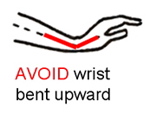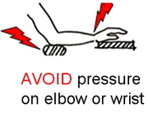A little self care and a few exercises as home remedies for wrist pain can both help relieve wrist pain and prevent further injury and long-term problems.
Although many people are concerned about developing carpal tunnel syndrome, many other conditions can be the cause of wrist pain, including:
- Bone fracture
- Bursitis
- Ganglion cyst
- Gout
- Muscle injury
- Osteoarthritis
- Rheumatoid arthritis
- Sprain (injury to a ligament)
- Tendonitis (injury to a tendon)
Consult a healthcare professional for a diagnosis.
How to Help Wrist Pain
If you work at a computer, here are some suggestions for your work set-up to help relieve wrist pain and prevent further repetitive strain injury.

- Place your keyboard at a height so your wrists are straight and level, and never bent back, as you type. If the height of your desk or table is not adjustable to a position where your wrists are straight, another option is to place the keyboard in your lap.
- When you type or use a mouse, do NOT rest your wrists on anything, and do NOT bend them up, down, or to the sides. Relax your hands just above the keyboard and keep your middle knuckle in alignment with the center of your wrist.
- Use your arms to move your hands, rather than resting your wrists on the desk or a pad and reaching with your fingers to type. To use the function keys, move your hand instead of reaching your fingers for the keys. Although you may have to get used to this approach, it can help prevent wrist pain and injury.
- Keep all your fingers and your thumb in a soft curve when you are typing. Notice if you keep your little finger raised or stiff. If so, consciously let the finger relax it to avoid injury.
- Use a light touch on the keys and avoid pounding.
- Hold the mouse lightly, avoiding a hard grip. When you stop typing, rest your hands in your lap or let your arms hang by your sides. Also, you can shake out your hands to renew the energy flowing through them.
- Set a reminder chime on your computer or some other reminder to take frequent stretching breaks. At a minimum, gently bend your wrists forward and backward and circle them in both directions. Another good exercise is to make tight fists and then let them relax; repeat 10 to 20 times.
You can also ask a massage therapist to help you deal with underlying
muscle tension that might be contributing to the pain or to provide injury massage.
Wrist Pain Relief Exercises
Exercises and stretches are important home remedies for wrist pain.
Wrist exercises can help keep your wrists mobile and strong and prevent problems. The forearm muscles that move the wrists are called wrist extensors and flexors. To flex your wrist, hold your hand with palm down and point the fingers downward. To extend your wrist, pull your hand back.
The following exercises are for generally healthy wrists feeling a little stiff or weak. If you have a specific wrist problem, consult a healthcare or exercise professional to adapt exercises for wrist pain to your specific needs.
Range of motion:
Start with active range of motion
exercises, simply extending and flexing your wrist and moving it from
side to side. Another option is to move your wrists in circles or figure
eights.
Stretches to help fix wrist pain:
Always be gentle using these wrist stretches for pain to avoid overstretching that can potentially tighten muscles or worsen injury.
- Extend one arm in front of you with the palm down and the elbow straight.
- Use your other hand to press on the back of the hand and bend it down (flexion). Release.
- Extend the wrist by pressing the fingers in a backward direction. Release.
Note: In general, hold each stretch for 15 to 30 seconds and repeat each one three times.
Wrist exercises for strength:
Using a light weight, move your wrist in the same motion as in the extension and flexion stretches. Start with only a few ounces and over time gradually add weight. If you feel wrist pain, use less weight.
Other Home Remedies for Wrist Pain
You can do some gentle self-massage using pain-relieving essential oils.
Use heat to relax stiff joints and muscles or cold to numb acute pain and reduce inflammation. Contrast therapy—alternating between heat and cold — can offer the benefits of both. (Learn more about hydrotherapy.)
Rest your wrists as needed.
Evaluate how you use your wrists and make changes that support healthy joints.
Braces or splints are sometimes suggested, but be careful you don’t
use them so much that they cause the muscles around the wrist to become
weak.
Photo Credit: staras / 123RF Stock Photo


